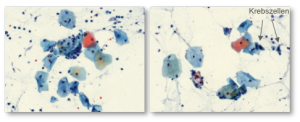Cervical cancer diagnostics
Cytology-based diagnostics – Pap smear
During the examination the gynecologist takes a scrape from the uterine cervix using a specific brush. In a specialized cytology laboratory this cervical smear is stained and visually inspected by microscopy for the presence of abnormal cells, which may be indicative for certain diseases. The quality of the results of this Pap smear (invented by the physician George Papanicolaou) largely depends upon the experience of the cytology laboratory. Therefore the results are not always reliable. Quite frequently the Pap smear yields a result Pap III or Pap IIID which does not unequivocally indicate cancer. Most dysplasias causing such a Pap smear result do heal spontaneously.
Detection of papillomaviruses – HPV tests
For triage, testing for the presence of the human Papillomaviruses causing cervical cancer may be performed. Especially in the case of abnormal Pap smear results HPV tests may contribute to further clarification. These tests are, like the Pap test, also made from a cervical smear. In case of a negative HPV test result, a precancerous lesion or cancer can be excluded, even if the Pap smear result was abnormal.
A positive HPV test, however, does not contribute to clarification, since in most of these cases the infections may clear, and the lesions may heal.
We have developed GynTect® in order to provide you with a decision support and to minimize uncertainty.

